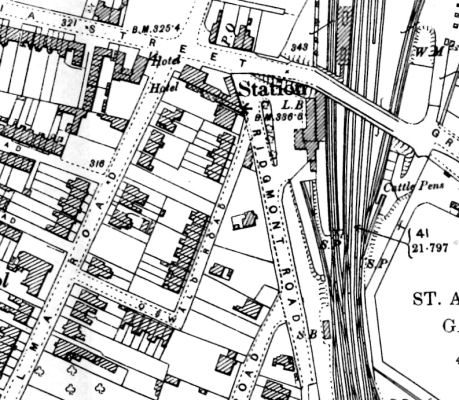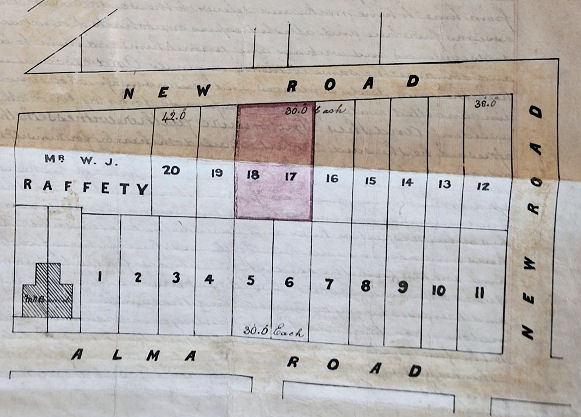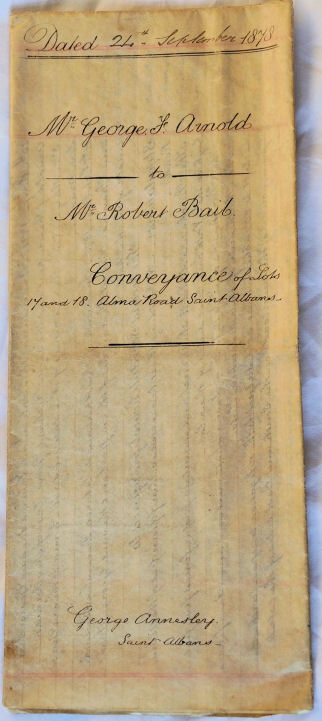|
|
BAIL, Oswald Road, St Albans, from 1878 April, 2011 |
|
Greg Stewart (iigregii @t hotmail.com) writes: Last September we bought our (first!) house in Oswald Road, moving from West London to St Albans. A few days after arriving our exchange solicitor almost carelessly shoved through our letter box an envelope. When I went through it it seemed a treasure trove: beautiful, original, handwritten documents relating to the origins of the house we'd bought but also others on the street. Indentures, conveyance, a will and codicil - I decided that whilst it was still possible I should makes some sense of them.
Here's what I've found, however if you could help with explaining the history of the street I'd be grateful. I can also send you pictures of the original document - careful italicised hand with ornate titles on manuscript.The story as I have it: in 1878, George Farr Arnold sells plots of land on auction at the Peahen Hotel. They are next to Alma Road, on a street penned in as 'New Road'. A buyer of two plots at £117: Robert Bail. An Engine Driver born in Syston in Leicestershire circa 1842, he has four houses built on the land. Residents will legally be allowed to have drainage, lighting and so on on New Road, and access including by carriage. As I've found out thanks to you, the houses are presumably built by bricks George provided - he was onto a good deal! 1880 Robert Bail borrows money against the houses, and seems to be building more elsewhere. By 1917 when he passes he owns 13 properties. He leaves no children, and leaves all to nephews. However in a codicil, an afterthought to his will, he leaves the use of this row of 4 houses to Mary Ann Dalley. She is the widow wife of George Dalley - he'd been an Ostler at the Peahen before becoming landlord of the Midland Railway Hotel. Mary Ann lives almost another 40 years. There is no sign of why Robert leagued so much to Mary Ann - except that they have the same street address in 1917 (8 Clarence Road). There is no sign either of Robert's original home on Oswald Road - he lived at Rose Cottage, which becomes one of Cardigan Villa or Oswald Villa.
You are very lucky to have such a bundle of documents - as when such documents survive they provide an excellent starting point for the history of the house, and in your case the area.
|
The area around the Midland Station was open fields until the Station was opened in 1868, when a wave of building started. This extract from the 1897 Ordnance Survey Map shows Oswald Road as it was then. The St Albans Library almost certainly has other maps of other dates. This map shows three blocks of terrace cottages 6 on the part connecting with Alma Road and then two blocks of 11 and 6 cottages. The houses on large plots between Oswald Road and Ridgmont Road were probably associated with Ridgmont Road. |
 |
More can be gained by looking at the houses. Google Street View shows that the first group of cottages are still there, and the first four carry a plaque with the name "SUBATHU VILLAS" and a date. (Not clear on picture - Greg provided correct spelling.) The next two of the group were built separately (note change in brickwork) but to a similar style. The group of 11 are definitely in two different styles - suggesting they were built in stages. The gap is now filled by three houses - I guess the older pair are pre First World War. The next 6 are all of the same style, but unfortunately no plaque. A look at at the other side of the street show only one house shown on the map (now numbered 35) was built to face on Oswald Road. Pictures of the area when it was fields are unlikely to exist and while there are early postcards of Victoria Street, minor side roads of terrace houses would not normally have been considered important enough to record in this way. However it is always worth checking in St Albans Central Library.
You can see who was living in Oswald Road in the 1881 (when it would seem virtually all the houses were built but not all occupied), 1891, 1901 and 1911 censuses, and there are street directories in the St Albans Central Library covering the same period - although the earlier ones may not provide full coverage. Putting all this information together with the maps may allow you to work out who was living in each house and when.
The library will have microfilm copies of the Herts Advertiser - so you should be able to find adverts for the sale - and perhaps an account of the sale, including who brought the other plots and for how much.
At the time the houses were built the fields were being brought up by speculators who were often local builders or brick makers, and the roads were laid out. The plots were then sold and houses built. Terraces of houses were built for letting - and the standard way of providing for your old age, if you had a bit of spare money, was to buy cottages so you could live on the rent income.
So how could Robert afford to buy the plot and build the houses. He is listed in all the censuses between 1851 and 1911. He was working as a railway cleaner in 1861 and as an engine driver between 1871 and 1901, and as a gentleman in 1911 - a term often used to describe a retired man of independent means. Between 1861 and 1901 he is described as unmarried and I suspect the married 30 years record in the 1911 census is an error. He was boarding in 1861, 1871, 1881 (in Lattimer Road, St Albans) and 1891 (in Oswald Road). In 1901 he was living in Oswald Road, and he was visiting nephews in 1911.
Well Robert was a railway engine driver and if he was on the faster long distance passenger trains he probably had one of the highest incomes of the blue collar workers in the industry. At the time a typical farm labourer might have been paid something around 10 shillings a week. You would have to look for the information in specialist railway history books but I would guess Robert could have been getting between £1 and £1 10 shillings a week. But the average farm labour would be supporting a wife and several children - while Robert was single and living in lodgings - possibly spending nights at both ends of the line. If he kept away from too much wine, women and song he might have been able to save more every week than the average farm labourer earned. Even if he started with no savings when he was just a railway cleaner in 1861 he should have been able to save enough to buy the plots in 1878. By 1881 the houses were built and he would have been getting rent income as well as his pay as an engine driver. It is interesting to speculate whether, in 1891, he was boarding in the house of one of his tenants - perhaps letting her off the rent in return for use of the room. While he is shown as "head of household" in a house in Oswald Road in 1901, it may well be a different house to the one in 1891, and he may never have lived "permanently" in any of his houses, but just used one on occasions when it didn't have a tenant. By the 1911 census he would be retired and as he was living on the rent from his cottages, rather than working until he collapsed, he would be considered a "gentleman."
As to Mary Ann Dalley, one must remember that Robert was 75 when he died, and would undoubtedly have known her in his local pub, the Midland Railway Hotel. Maybe he lodged with her at some stage, and maybe she was helping to nurse him in his old age.
~~~~~

|
Greg has provided scans of the old deeds which refer to the houses. The first is a conveyance which records that Robert Bail purchased plots 17 and 18 of an estate on Alma Road in 1878. They were sold at auction at the Peahen for £117, The document records that the seller, George Farr Arnold, had purchased the land (and possibly much more) from the British Land Company Limited in 1869. The above map comes from the document.
Next is a mortgage for £500 at 5% per year taken out in 1880 on four leasehold cottages referred to as numbers 10, 11, 12 and 13 Oswald Road. This indicated that 4 cottages have been built on the two plots and the mortgage may well be to cover the building costs. While there is no mention of the tenants or the rent being charged, Robert would have needed a rent of 2s 6d a week from each cottage simply to pay the interest. However the loan may have been, in part at least, to cover the cost of other land or properties as by 1892 he owned two more houses in Oswald Road. The next document is a 1892 mortgage where a loan of £800 is granted by Thomas Kent, brewer of St Albans, to Robert Bail, engine driver of Cardigan Villa, Oswald Road, St Albans. The security was the four cottages, now numbered 10, 11, 12, and 13 Oswald Road, occupied by tenants Ernest Shepherd, Frederick Woodman, George Hill and Mrs Waller, together with two other Oswald Road properties, Cardigan Villa and Oswald Villa, with tenants Fanny Croften and Sarah Page. The copy will, with codicil, from 1917 leaves the four cottages, now numbered 24, 26, 28 & 30 Oswald Road to his nephew (and executor) George Archibald Sheffield, but to be for the benefit of Mrs Mary Ann Dalley during her lifetime or until she remarried. The two Villas of 1892, referred to as 49 and 51 Oswald Road, were sold to a Mr R. L. Samuel by George's executors in September 1918, as two further houses in St Albans, "Harefield" and "Ingleside" 24 & 26 Ridgemont Road, were also sold. These may well be plots backing onto Oswald Road adjacent to the villas. Robert also left property in Syston, Leicestershire to his niece Agnes Fanny Whall, and the residue was to be divided between a number of nephews and nieces.
An interesting additional point was that Robert was a Freemason, leaving his apron, two jewels and three emblems to his niece. There is no indication which lodge he was a member of.
|
||



